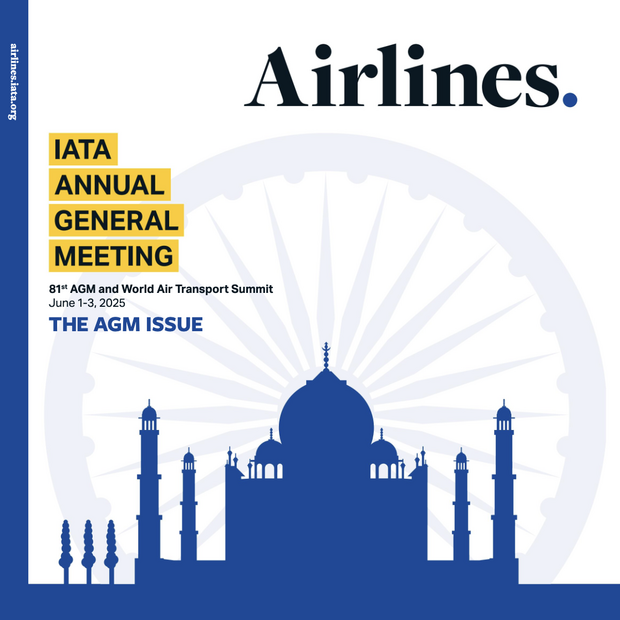
Translations: 国际航协:5月客运需求增长5% (pdf)
La demanda de pasajeros aéreos crece 5% en mayo (pdf)
Croissance du trafic de passagers de 5 % en mai (pdf)
Crescimento da demanda de passageiros atinge 5% em maio (pdf)
Geneva - The International Air Transport Association (IATA) released data for May 2025 global passenger demand with the following highlights:
- Total demand, measured in revenue passenger kilometers (RPK), was up 5.0% compared to May 2024. Total capacity, measured in available seat kilometers (ASK), was also up 5.0% year-on-year. The May load factor was 83.4% (-0.1 ppt compared to May 2024).
- International demand rose 6.7% compared to May 2024. Capacity was up 6.4% year-on-year, and the load factor was 83.2% (+0.2 ppt compared to May 2024). This is a record load factor on international flights for May.
- Domestic demand increased 2.1% compared to May 2024. Capacity was up 2.8% year-on-year. The load factor was 83.7% (-0.5 ppt compared to May 2024).
“Air travel demand growth was uneven in May. Globally, the industry reported 5% growth with Asia-Pacific taking the lead at 9.4%. The outlier was North America which reported a 0.5% decline, led by a 1.7% fall in the US domestic market. Severe disruptions in the Middle East in late June remind us that geopolitical instability remains a challenge in some regions as airlines maintain safe operations with minimal passenger inconvenience. The impact of such instability on oil prices—which remained low throughout May—is also a critical factor to monitor. Importantly, consumer confidence appears to be strong with forward bookings for the peak Northern summer travel season, giving good reason for optimism,” said Willie Walsh, IATA’s Director General.
Air Passenger Market in Detail
| May 2025 (% year-on-year) | World Share1 | RPK | ASK | PLF(%-PT)2 | PLF(Level)3 |
|---|---|---|---|---|---|
| Total Market | 100% | 5.0% | 5.0% | -0.1% | 83.4% |
| Africa | 2.2% | 7.5% | 4.6% | 2.0% | 75.3% |
| Asia Pacific | 33.5% | 9.4% | 7.1% | 1.8% | 83.8% |
| Europe | 26.7% | 3.4% | 3.9% | -0.4% | 84.7% |
| Latin America | 5.3% | 8.5% | 9.6% | -0.8% | 82.2% |
| Middle East | 9.4% | 6.2% | 6.7% | -0.4% | 80.7% |
| North America | 22.9% | -0.5% | 2.0% | -2.1% | 83.4% |
1) % of industry RPK in 2024 2) Year-on-year change in load factor 3) Load Factor Level
Regional Breakdown - International Passenger Markets
International RPK growth reached 6.7% in May year-on-year, with growth in all regions but a mixed picture on load-factors, which increased only by 0.2 ppt. Traffic expansion on most key international routes to the Americas slowed in May, apart from Transatlantic with a modest 2.5% year-on-year increase.
Asia-Pacific airlines achieved a 13.3% year-on-year increase in demand. Capacity increased 10.6% year-on-year, and the load factor was 84.0% (+2.0 ppt compared to May 2024).
European carriers had a 4.1% year-on-year increase in demand. Capacity increased 4.8% year-on-year, and the load factor was 84.0% (-0.6 ppt compared to May 2024).
North American carriers saw a 1.4% year-on-year increase in demand. Capacity increased 1.7% year-on-year, and the load factor was 83.8% (-0.3 ppt compared to May 2024).
Middle Eastern carriers saw an 6.2% year-on-year increase in demand. Capacity increased 6.3% year-on-year, and the load factor was 80.9% (-0.1 ppt compared to May 2024).
Latin American airlines saw an 8.8% year-on-year increase in demand. Capacity climbed 11.0% year-on-year. The load factor was 83.6% (-1.7 ppt compared to May 2024).
African airlines saw a 9.5% year-on-year increase in demand. Capacity was up 6.2% year-on-year. The load factor was 74.9% (+2.2 ppt compared to May 2024). Africa-Asia is the fastest-growing international corridor, with an expansion of 15.9%.
Domestic Passenger Markets
Domestic RPK rose 2.1% over May 2024 and load factor fell by -0.5 ppt to 83.7% on the back of a 2.8% capacity expansion. All regions showed growth except in the United States, due to economic slowdown and reductions in government travel. Chinese domestic travel growth accelerated, as it has been doing every month since March. Also notable is Brazil’s strong growth, on the back of unbroken expansion since January 2023.
| May 2025 (% year-on-year) | World Share1 | RPK | ASK | PLF(%-PT)2 | PLF(LEVEL)3 |
|---|---|---|---|---|---|
| Domestic | 38.2% | 2.1% | 2.8% | -0.5% | 83.7% |
| Domestic Australia | 0.8% | 1.0% | 0.0% | 0.8% | 79.2% |
| Domestic Brazil | 1.1% | 18.3% | 15.7% | 1.8% | 81.2% |
| Domestic China P.R. | 11.3% | 7.4% | 4.8% | 2.0% | 84.3% |
| Domestic India | 1.6% | 3.1% | 9.6% | -5.3% | 83.5% |
| Domestic Japan | 1.0% | 5.8% | -1.1% | 5.0% | 76.9% |
| Domestic US | 14.4% | -1.7% | 2.0% | -3.1% | 83.0% |
1) % of industry RPK in 2024 2) Year-on-year change in load factor 3) Load Factor Level
Note: the six domestic passenger markets for which broken-down data are available account for approximately 30.2% of global total RPKs and 79.1% of total domestic RPKs.
> View the May 2025 Air Passenger Market Analysis (pdf)
For more information, please contact:
Corporate Communications
Tel: +41 22 770 2967
Email: corpcomms@iata.org
Notes for Editors:
- IATA (International Air Transport Association) represents some 360 airlines comprising over 80% of global air traffic.
- You can follow us on X for announcements, policy positions, and other useful industry information.
- Fly Net Zero
- Statistics compiled by IATA Economics using direct airline reporting complemented by estimates, including the use of FlightRadar24 data provided under license.
- All figures are provisional and represent total reporting at time of publication plus estimates for missing data. Historic figures are subject to revision.
- Domestic RPKs accounted for about 38.2% of the total market in 2024. The six domestic markets in this report account for 30.2% of global RPKs.
- Explanation of measurement terms:
- RPK: Revenue Passenger Kilometers measures actual passenger traffic
- ASK: Available Seat Kilometers measures available passenger capacity
- PLF: Passenger Load Factor is % of ASKs used.
- IATA statistics cover international and domestic scheduled air traffic for IATA member and non-member airlines.
- Total passenger traffic market shares by region of carriers for 2024 in terms of RPK are: Asia-Pacific 33.6%, Europe 26.7%, North America 22.9%, Middle East 9.4%, Latin America 5.3%, and Africa 2.2%.

